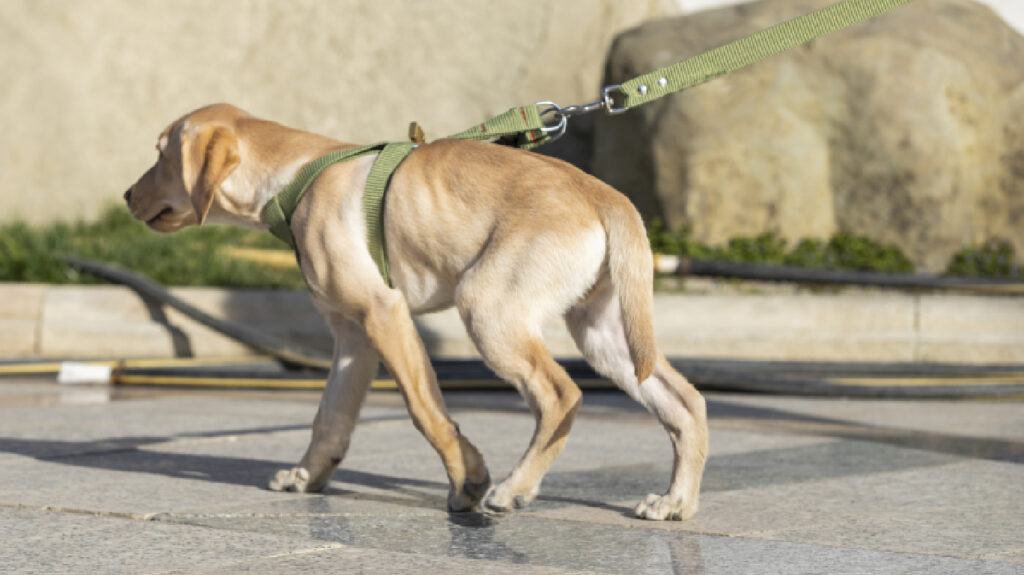
Caring for a Mobility-Impaired Dog: Best Practices for Handling Dogs with IVDD
Is your dog suffering from Intervertebral Disc Disease (IVDD) and you’re not sure how to best care for them? This comprehensive guide covers everything you need to know about IVDD, including its causes, signs and symptoms, diagnosis, and treatment options.
We’ll also discuss the best practices for handling and caring for a mobility-impaired dog. This includes creating a safe environment and managing pain and discomfort. Whether your furry friend is undergoing conservative management or surgery, these tips will help make their journey to recovery as comfortable as possible.
What is IVDD?
Intervertebral disc disease (IVDD), commonly known as a spinal disc herniation, is a condition that affects dogs, particularly in the canine community, and requires veterinary care.
IVDD can cause pain, weakness, and even paralysis in affected dogs, making it a debilitating condition.
Professional veterinary care is essential for accurate diagnosis and determining the most effective treatment plan. This may involve medication, physical therapy, or surgery. Early diagnosis and treatment are crucial in managing IVDD and preventing further damage to the spinal cord.
Supportive care, including rest, medication, and restricted activity, plays a vital role in aiding the recovery process for canines with IVDD. This promotes their overall well-being and minimizes discomfort.
What Causes IVDD in Dogs?
IVDD in dogs is primarily caused by the degeneration of intervertebral discs, often seen in specific breeds and canines with genetic predispositions, requiring proactive preventive measures and vigilant veterinary care.
This condition is particularly prevalent in breeds like Dachshunds, Beagles, and Corgis, due to their unique vertebral conformation. Genetic factors play a significant role, making it essential for pet owners to be mindful of the breed susceptibility and take preemptive steps to reduce the risk of IVDD.
Regular exercise, maintaining a healthy weight, and providing proper support during jumps and rough play can all contribute to preventing IVDD. Scheduled veterinary check-ups are crucial for early detection and supportive care to improve the quality of life for dogs prone to this condition.
What are the Signs and Symptoms of IVDD?
Recognizing the signs and symptoms of IVDD in canines is crucial for prompt diagnosis and effective management, enabling pet owners to seek timely veterinary care and support.
As a pet owner, it’s crucial to stay alert for any changes in your dog’s mobility. This could include hesitance to jump, play, or move their neck. Other common symptoms to watch for are back pain, limb weakness, and loss of bladder or bowel control. Early diagnosis is crucial, as delaying veterinary intervention can result in more severe complications. By scheduling regular check-ups and paying attention to any unusual behavior, pet owners can play a crucial role in identifying potential signs of IVDD in their beloved furry companions.
How is IVDD Diagnosed?
The diagnosis of IVDD in canines involves a comprehensive assessment by veterinarians, including physical examinations, neurological evaluations, and diagnostic imaging techniques, leading to tailored treatment plans and supportive care.
Physical examinations are crucial in identifying signs of pain, muscle atrophy, or altered gait. Neurological evaluations determine the degree of spinal cord involvement.
Diagnostic imaging, such as MRI or CT scans, provides detailed visualization of disc herniation. These examinations help devise personalized treatment plans, which may include pain management, physical therapy, or surgical intervention. Supportive care, including rest, anti-inflammatory medications, and rehabilitation, is vital for successful outcomes in dogs with IVDD.
What are the Treatment Options for IVDD?
The treatment of IVDD in canines encompasses a spectrum of options, including conservative management and surgical interventions, aimed at effective disease management and the restoration of mobility and comfort.
Conservative management for IVDD often involves strict crate rest, anti-inflammatory medications, and physical therapy to reduce inflammation and support natural healing.
On the other hand, surgical interventions may be necessary for severe cases where conservative approaches yield limited improvement. These procedures can involve decompression surgery, such as hemilaminectomy or fenestration, to relieve spinal cord compression and alleviate symptoms. Both approaches play a crucial role in the comprehensive management of IVDD, tailored to each dog’s condition and response to treatment.
Conservative Management
Conservative management for IVDD in canines involves a multifaceted approach, integrating physical therapy, supportive care, and rehabilitation exercises to promote mobility and enhance the overall well-being of the affected dogs.
This comprehensive approach aims to address the physical limitations and pain associated with IVDD through targeted exercises tailored to improve flexibility, strength, and coordination. Supportive care such as pain management, weight management, and modifications to the dog’s environment play a crucial role in creating a conducive atmosphere for recovery.
By focusing on rehabilitation and supportive care, the treatment plan prioritizes the holistic well-being of the canine, fostering a balanced and sustainable path to improved health.
Surgery
Surgical intervention for IVDD in canines aims to address spinal cord compression and neurological deficits, facilitating the potential for recovery and improved mobility post-surgery.
Spinal surgery procedures involve removing extruded or herniated disc material and relieving pressure on the spinal cord. This helps to restore neurological function and offers a chance for significant improvement in limb function and overall mobility by addressing the underlying cause of the condition.
Following surgery, a structured rehabilitation plan is crucial in accelerating recovery and ensuring optimal outcomes for the affected dog. Close monitoring of progress and appropriate support during the post-operative phase are essential for enhancing the likelihood of successful recovery.
How to Care for a Mobility-Impaired Dog?
Caring for a mobility-impaired dog with IVDD involves creating a safe and supportive environment, implementing mobility aids, and providing holistic support to enhance their quality of life.
This comprehensive care approach is crucial for supporting the physical and emotional well-being of these unique companions. Supportive care encompasses pain management, physical therapy, and close monitoring of their condition.
In addition, the use of mobility aids such as harnesses, wheelchairs, and ramps can greatly improve their mobility and independence. Environmental modifications, such as providing non-slip flooring and easy access to food, water, and resting areas, help ensure their safety and comfort. By combining these elements, canine wellness can be maximized, allowing dogs with IVDD to lead fulfilling lives.
Provide a Safe and Comfortable Environment
Creating a safe and comfortable environment for a mobility-impaired dog with IVDD involves implementing adaptations and modifications to the home setting, ensuring optimal support and accessibility for the affected canine.
When caring for a dog with IVDD, it’s important to make necessary accommodations to assist them in accessing elevated surfaces and ensuring clear pathways to prevent falls. This may include ramps or steps and using non-slip flooring surfaces for stability.
Additionally, consider the placement of food and water dishes at an accessible height and provide comfortable resting areas with supportive bedding. Regular vet check-ups and monitoring weight are also crucial for the dog’s overall well-being.
Assist with Mobility
Assisting with the mobility of a dog affected by IVDD involves the use of mobility aids, physical therapy, and exercise regimens to promote muscle strength, joint health, and overall rehabilitation.
There are several ways to improve the quality of life for dogs with IVDD. Mobility aids, such as carts or harnesses, can provide support for the affected area and reduce strain, allowing the dog to move more comfortably.
Physical therapy is also beneficial, as it can be tailored to the dog’s specific needs and help regain strength and flexibility. Targeted exercises for muscle groups and joint mobility are crucial in maintaining and improving overall function, promoting the dog’s mobility and well-being.
Monitor for Urinary and Bowel Incontinence
Monitoring urinary and bowel function in dogs with IVDD is essential, including bladder expression techniques and interventions to ensure urinary health and prevent complications related to incontinence.
Owners of dogs with IVDD should be vigilant in observing their pet’s urinary and bowel habits. Early detection of incontinence issues can lead to timely interventions.
Regular bladder expression plays a crucial role in managing urinary health. It helps prevent urinary retention and potential bladder infections. Implementing strategies suchb as maintaining a consistent bathroom schedule and providing ample opportunities for outdoor elimination can aid in maintaining healthy urinary function in dogs with IVDD.
Manage Pain and Discomfort
Managing pain and discomfort in dogs with IVDD involves a comprehensive approach, incorporating pain relief strategies, medication, and supportive care to ensure their well-being and quality of life.
When it comes to managing pain in dogs, it’s important to take a multifaceted approach that addresses all aspects of their condition. This can include techniques like massage, physical therapy, and acupuncture, which can help alleviate discomfort. In some cases, medication may also be prescribed by a veterinarian, such as nonsteroidal anti-inflammatory drugs or opioids.
In addition to these methods, supportive care measures are also crucial for the dog’s overall well-being and pain relief. This can include creating a comfortable environment for them, providing mobility support, and adjusting their diet to meet their specific needs.
Follow a Special Diet and Exercise Plan
Following a special diet and exercise plan tailored to the needs of dogs with IVDD is essential. This includes nutritional support, weight management, and customized exercise regimens to promote their overall health and well-being.
This specialized approach addresses the unique challenges that dogs with IVDD face. They may require specific nutrients to support spinal health and maintain a healthy weight to reduce pressure on their spine.
By incorporating tailored exercise strategies, such as controlled walks and gentle stretching, dogs with IVDD can improve their mobility and strength while minimizing the risk of further injury. This holistic approach looks beyond just managing the condition to supporting the dog’s overall wellness and quality of life.
What are the Best Practices for Handling Dogs with IVDD?
Implementing best practices for handling dogs with IVDD involves gentle care, the use of support harnesses, and regular communication with veterinarians to ensure the well-being and comfort of the affected canines.
This approach requires a deep understanding of the condition and its implications, as well as the necessary patience and attentiveness.
Utilizing support harnesses can alleviate pressure on the affected areas and facilitate movement, enhancing the dog’s comfort.
Regular communication with veterinarians is crucial to monitor the dog’s progress, adjust the care plan, and address any emerging issues promptly.
By integrating these best practices, dog owners can significantly improve the quality of life for their pets living with IVDD.
Avoid Rough Play and Jumping
Engaging in gentle activities and avoiding rough play and jumping is essential in adhering to exercise restrictions and providing behavioral support for dogs with IVDD, ensuring their physical and emotional well-being.
This approach helps in preventing further injury to their delicate spinal cord and promotes a safe environment for their recovery.
Behavioral support, such as positive reinforcement training and mental stimulation, plays a crucial role in maintaining their mental health and reducing stress.
Gentle activities like short walks, low-impact exercises, and interactive play provide the necessary physical activity while minimizing the risk of exacerbating their condition.
By understanding and adhering to these exercise restrictions, pet owners can greatly contribute to their dog’s comfort and overall quality of life.
Use a Support Harness or Sling
Utilizing a support harness or sling can significantly aid in the mobility improvement and assistance for dogs with IVDD, providing them with the needed support and stability during movement.
Assistive devices are designed to relieve pressure from a dog’s spine, promoting more comfortable and less painful movement. Support harnesses and slings can also prevent further injury by supporting the dog’s body weight, which is crucial for those recovering from IVDD-related issues.
By using these tools, pet owners can actively aid in their dog’s recovery and ensure that their beloved companions can maintain active and fulfilling lives despite dealing with IVDD.
Be Gentle and Patient
Providing gentle care and demonstrating patience is vital for offering emotional support and promoting the bond with dogs affected by IVDD, ensuring their mental well-being and resilience.
This emotional support plays a crucial role in the recovery process. Dogs with IVDD rely heavily on the bond and comfort provided by their owners or caregivers.
Patience in understanding their limitations and creating a safe environment can have a profound impact on their mental and emotional stability. The nurturing relationship between the dog and their caregiver is instrumental in fostering a sense of security and trust, which aids in their overall well-being and resilience.
Consult with a Veterinarian Regularly
Regular consultations with veterinarians are essential for caregiver support, providing ongoing care coordination, and ensuring the comprehensive well-being of dogs with IVDD.
Regular veterinary visits are crucial for managing the unique needs and challenges associated with IVDD. These visits allow veterinarians to monitor the dog’s progress, adjust treatment plans, and provide guidance on preventive measures. By staying updated on the dog’s condition, caregivers can proactively address any issues and maintain the dog’s overall health and happiness.




No Comments